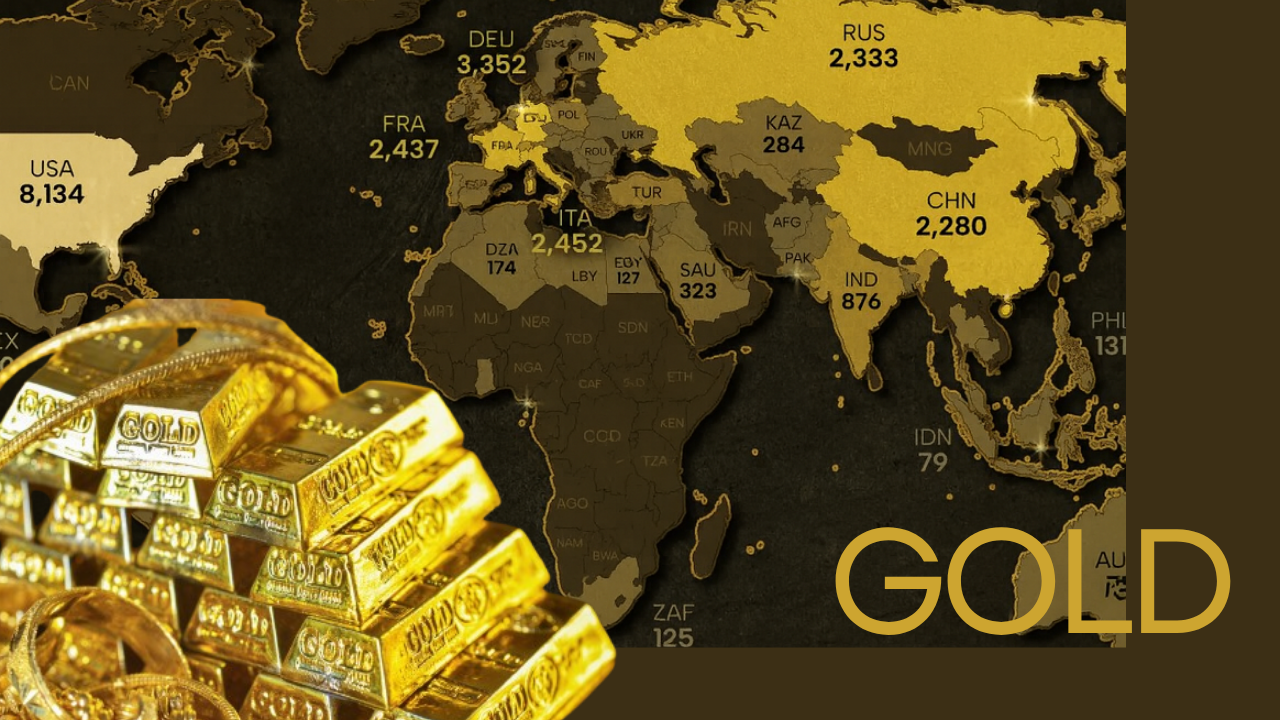
Central banks in Thailand, Kazakhstan and Singapore have also cited inflation risks, currency fluctuations and shifting geopolitical alignments as reasons for steadily increasing their gold exposure.
Gold has returned to the center of the global financial conversation. With prices hitting record highs in early 2025 and the world navigating inflation, geopolitical instability and currency volatility, central banks have resumed a pattern that began years ago: buying more gold than at any point since the late 1960s. New data from BullionVault underscores just how concentrated global official reserves remain—and how sharply the international landscape is shifting beneath the surface.
The US and Europe Still Anchor the Global Gold System
The United States remains the undisputed leader in official gold ownership. Its holdings-8,133.5 tonnes—have barely changed for decades, reflecting a long-standing strategic decision to maintain a massive physical stockpile. Most of this gold sits in Fort Knox, the Denver Mint and the vaults of the New York Federal Reserve. At current valuations, the US hoard comfortably exceeds $1 trillion.
Europe, when viewed collectively, forms the second great pillar of the gold-based financial order. Germany holds 3,351.6 tonnes, Italy owns 2,451.9 tonnes, and France maintains 2,437 tonnes. These reserves, much of which trace back to the Bretton Woods era, continue to serve as anchors of credibility for Europe’s monetary framework. Taken together, Europe’s top economies rival the US in sheer tonnage—even if they remain divided across national borders.
Despite years of quantitative easing, debt expansion and currency fluctuations, neither the US nor Europe has meaningfully reduced its gold exposure. If anything, their posture reinforces a clear message: gold continues to function as the ultimate backstop in a world marked by rising geopolitical risk.
2025 Gold Reserve Rankings- Largest Holders
1. United States — 8,133.5 tonnes
Still the world’s largest holder; stockpile valued at $1 trillion+.
2. Germany — 3,351.6 tonnes
3. Italy — 2,451.9 tonnes
4. France — 2,437 tonnes
5. China — 2,279.6 tonnes
Added 331 tonnes between 2019–2024.
6. Russia — (approximately ~2,300 tonnes)
7. Switzerland — 1,039.9 tonnes
8. India — 876.2 tonnes
9. Japan — 846 tonnes
10. Turkey — 595.4 tonnes
Asia Quietly Builds Its Own Gold Buffer
While the West still dominates, Asia’s accumulation story has become impossible to ignore.
China has been steadily expanding its official reserves, adding 331 tonnes between 2019 and 2024 to reach 2,279.6 tonnes. This buildup is closely tied to Beijing’s long-term strategy of reducing reliance on the US dollar and diversifying away from US Treasuries. As US–China tensions deepen and sanctions take on a broader geopolitical role, China’s gold policy has taken on new urgency.
India, now the world’s fifth-largest economy, holds 876.2 tonnes. Its purchases have accelerated in recent years as the Reserve Bank of India boosts its bullion buffer to hedge against global currency swings and rising import bills. Japan follows closely behind with 846 tonnes.
Beyond these giants, several emerging markets have been quietly but aggressively building reserves. Turkey has lifted its holdings to 595.4 tonnes, while Poland has added gold at one of the fastest rates among EU members, reaching 448.2 tonnes. For both countries, domestic currency volatility and geopolitical shocks have strengthened the case for bullion.
The Layer Beneath the Headlines: Smaller Nations Add Steadily
Alongside the major players, a cohort of smaller but gold-heavy economies continues to fortify reserves. Switzerland maintains 1,039.9 tonnes, reflecting its long tradition as a global financial vault. Uzbekistan has increased its holdings to 382.6 tonnes, while Saudi Arabia holds roughly 323.1 tonnes—figures that underline how gold remains a preferred hedge for commodity-driven and geopolitically exposed economies.
Central banks in Thailand, Kazakhstan and Singapore have also cited inflation risks, currency fluctuations and shifting geopolitical alignments as reasons for steadily increasing their gold exposure.
A World Still Dominated by Old Financial Centers
Despite rising purchases across Asia and emerging markets, the distribution of global gold remains heavily skewed. The US and Europe together control more than 60% of all reported official gold reserves—an extraordinary level of concentration that continues to shape global monetary dynamics.
China, India and other developing economies are catching up, but the gap remains wide. Even as purchasing trends shift, it will likely take decades for the global reserve map to meaningfully rebalance away from the traditional financial centers of the West.
Yet the direction of momentum is unmistakable. Central banks from emerging markets are no longer passive participants in the global system—they are actively preparing for a future where currency wars, sanctions and geopolitical realignment make gold more relevant than it has been in half a century.
What the 2025 Rankings Signal About the Future
The 2025 gold-reserve landscape reveals a world hedging against uncertainty. Gold may no longer define monetary systems as it did under Bretton Woods, but its role as a neutral store of value has regained strength amid growing doubts about major fiat currencies.
As inflation remains elevated, geopolitical blocs harden and financial systems fragment, central banks are reinforcing their defenses the old-fashioned way—by stockpiling gold. While the West still leads, the rise of Asia’s gold accumulation hints at a long-term shift in the architecture of global reserves.
For now, however, the map remains familiar: the United States, Europe, and a handful of traditional financial powers remain firmly in control of the world’s most coveted monetary asset—even as the next wave of buyers quietly reshapes the future.

